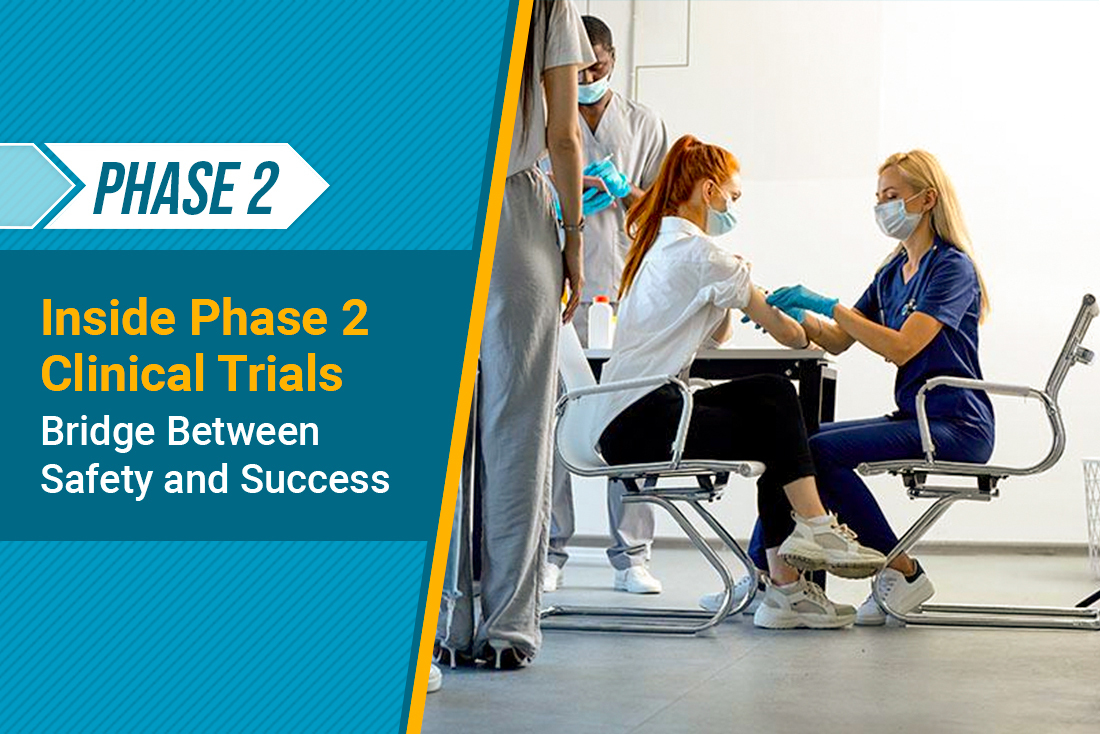Estimated Read Time: 4 minutes
Phase 2 clinical trials are a crucial part of progressing a new medicine or treatment – such as a potentially life-saving therapy for cancer like mesothelioma – to FDA approval and general patient use.
As the second part in the multi-step clinical trial and approval process, let’s review the purpose of phase 2 clinical trials and why they are so important.
To catch up, read about the purpose of phase 1 clinical trials.
What Is a Phase 2 Clinical Trial?
A phase 2 clinical trial is the second stage of testing a novel treatment in humans, following the initial safety-focused phase 1 trial. By this point, researchers have determined a relatively safe dose range for the therapy and understand the basic pharmacokinetics (how the drug moves through the body).
Now, they begin testing the treatment in larger groups of patients who actually have the disease or condition being studied. The goal is to gather more data about how effective the treatment is at fighting the condition, while continuing to monitor safety closely.
Understanding why Phase 2 Is Important
This is often called the “proof of concept” phase. Phase 2 trials provide early evidence of how well a new treatment performs under controlled conditions. While phase 1 studies may involve healthy volunteers, phase 2 studies focus on patients with the illness in question, so the data is much more relevant.
For example, in a phase 2 clinical trial for lung cancer, scientists examine whether the treatment is effective at stopping or slowing down the spread of tumors in people with lung cancer. If the trial is for mesothelioma, which is a rare type of cancer that starts in the lining of the lungs, abdomen or heart, then scientists will use people with mesothelioma.
If the treatment shows strong signs of efficacy, it can move to larger, confirmatory trials (phase 3). If not, development may be paused to figure out how to make the therapy more effective, or stopped altogether. So phase 2 plays a critical role in deciding whether to progress a therapy forward in development.
Priorities in Phase 2: Efficacy and Safety Together
Safety is still a concern in phase 2 clinical trials. Scientists monitor for safety data, such as whether patients with this cancer have any troublesome reactions or side effects from using the therapy.
However, the drug’s effectiveness in treating the disease takes center stage. Researchers want to know if the treatment produces meaningful improvements in symptoms, disease progression or measurable biological markers.
Here’s an overview of the priorities in a phase 2 trial:
- Determining how well the treatment works for specific conditions or subgroups
- Fine-tuning the dosing regimen
- Identifying short- and medium-term side effects
- Establishing criteria to guide Phase 3 study design
During this phase of the clinical trial process, it’s all about finding the sweet spot of where a drug is effective enough to make a difference but still safe enough for patients to use. Sometimes, a treatment works well but causes unacceptable side effects at certain doses. Other times, side effects are minimal but the therapeutic effect isn’t strong enough to justify moving forward.
Researchers use carefully chosen outcome measures to determine if a treatment is having the intended effect. These can include symptom scores, lab values, imaging, biomarkers or other clinical endpoints.
What Determines Phase 2 Trial Size?
The size of a phase 2 trial depends on the disease being studied, the design of the trial and what researchers hope to learn. In general, 100-300 patients is the range of phase 2 studies.
In trials for rare diseases or featuring highly targeted therapies, such as gene therapy, trials may include fewer people. For instance, a phase 2 study in salvage malignant mesothelioma conducted at MD Anderson Cancer Center enrolled up to 58 patients, with only 28 actually receiving treatment.
Key factors influencing enrollment include:
- Objective of the study
– Safety/exploratory signals require less power, leading to smaller cohorts (30–60)
– Efficacy-driven endpoints (tumor response, PFS, OS) need larger samples (≥100) - Trial design
– Single-arm (everyone receives the therapy) versus randomized control group (some patients receive the therapy and others do not)
– Biomarker-based or dose-finding subgroups - Disease prevalence and site availability
– Rare cancers like mesothelioma have small enrollment since the patient population is limited - Statistical power targets
– Defined by expected effect size and acceptable error rates
Summary of Phase 2 Clinical Trials
Phase 2 clinical trials are where science gets serious. They bridge the gap between the lab and the clinic, offering the first real look at whether a new treatment could become a viable option for patients.
It’s a critical step filled with both opportunity and risk. Many therapies don’t make it past this phase for either safety or effectiveness reasons.
For those that do, the data gathered here lays the foundation for the final stages of testing and, hopefully, FDA approval.
Sources & Author
About the Writer, Dr. Stephen Williams, Precision Oncology Scientist
Dr. Stephen Williams is a Precision Oncology Scientist in the Department of Pathology and Laboratory Medicine at MD Anderson Cancer Center in Houston, Texas. Dr. Williams has served as a medical reviewer, guest blog writer, and medical content writer for Mesothelioma Guide since 2024. He helps the organization inform and educate patients and loved ones about cancer treatment – ensuring all content published on the Mesothelioma Guide website is accurate, concise, and clear.
Sources & Author



